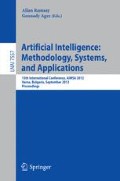Abstract
In order to develop truly intelligent systems, it is necessary to improve their ability to understand non-verbal communication. We propose a novel framework to recognize individuals and emotions from gait, in order to improve HRI. We collected the motion data of the torso from 4 professional actors’ gait, using motion capture system, and 7 non-actors’ using 2 IMU sensors. We developed Feature Value Method which is a PCA based classifier and finally we achieved high recognition rate through cross-validation.
Access this chapter
Tax calculation will be finalised at checkout
Purchases are for personal use only
Preview
Unable to display preview. Download preview PDF.
References
Loula, F., Prasad, S., Harber, K., Shiffrar, M.: Recognizing people from their movement. J. of Experimental Psychology: Human Perception and Performance 31(1), 210–220 (2005)
Jokisch, D., Daum, I., Troje, N.: Self-recognition versus recognition of others by biological motion: Viewpoint-depedent effects. Perception 35, 911–920 (2006)
Cutting, J., Kozlowski, L.: Recognizing friends by their walk: Gait perception without familiarity cues. Bulletin of Psychonomic Society 9(5), 353–356 (1977)
Jain, A., Bolle, J., Pankanti, S.: Biometrics-Personal Identification in Networked Society. Springer US (2002)
Nixon, M.: Gait biometrics. Biometric Technology Today 16(7-8), 8–9 (2008)
de Gelder, B.: Towards the neurobiology of emotional body language. Nature Reviews, Neuroscience 7, 242–249 (2006)
Taylor, G.W., Hinton, G.E.: Factored conditional restricted Boltzmann Machines for modeling motion style. In: Proc. of the 26th International Conference on Machine Learning, pp. 1025–1032 (2009)
Murray, P., Drought, B., Kory, R.: Walking patterns of normal men. Journal of Bone and Joint Surgery 46(2), 335–360 (1964)
Boyd, J.E., Little, J.J.: Biometric Gait Recognition. In: Tistarelli, M., Bigun, J., Grosso, E. (eds.) Advanced Studies in Biometrics. LNCS, vol. 3161, pp. 19–42. Springer, Heidelberg (2005)
Troje, N.: Decomposing biological motion: A framework for analysis and synthesis of human gait patterns. J. of Vision 2(5), 371–387 (2002)
Kadone, H., Nakamura, Y.: Symbolic Memory of Motion Patterns by an Associative Memory Dynamics with Self-organizing Nonmonotonicity. In: Ishikawa, M., Doya, K., Miyamoto, H., Yamakawa, T. (eds.) ICONIP 2007, Part II. LNCS, vol. 4985, pp. 203–213. Springer, Heidelberg (2008)
Zhang, T., Venture, G.: Emotion Recognition from Walk Pattern. In: 21st An. Conf. of the Japanese Neural Network Society, Okinawa, Japan, pp. 196–197 (December 2011)
Venture, G.: Human Characterization and Emotion Characterization from Gait. In: Proc. of the IEEE Int. Conf. Engineering in Medicine and Biology, Buenos Aires, Argentina, pp. 1292–1295 (2010)
Kadone, H., Hicheur, H., Grezes, J., Berthoz, A.: Nature of the kin-ematic cues underlying the perception of emotions during human gait. In: Proc. of the XIX Conf. of the Int. Society for Posture and Gait Research, vol. O-25 (2009)
Vapnik, V.: The Nature of Statistical Learning Theory. Springer (1995)
Burges, C.: A Tutorial on Support Vector Machines for Pattern Recognition. Data Mining and Knowledge Discovery 2, 1–47 (1988)
Osuna, E., et al.: Support Vector Machines: Training and Applications, A.I. Memo 1602. MIT Press (1988)
Karg, M., et al.: A comparison of PCA, KPCA and LDA for feature extraction to recognize affect in gait kinematics. In: Proc. of the 3rd International Conference on Affective Computing and Intelligent Interaction (2009)
Author information
Authors and Affiliations
Editor information
Editors and Affiliations
Rights and permissions
Copyright information
© 2012 Springer-Verlag Berlin Heidelberg
About this paper
Cite this paper
Zhang, T., Venture, G. (2012). Biometrics from Gait Using Feature Value Method. In: Ramsay, A., Agre, G. (eds) Artificial Intelligence: Methodology, Systems, and Applications. AIMSA 2012. Lecture Notes in Computer Science(), vol 7557. Springer, Berlin, Heidelberg. https://doi.org/10.1007/978-3-642-33185-5_36
Download citation
DOI: https://doi.org/10.1007/978-3-642-33185-5_36
Publisher Name: Springer, Berlin, Heidelberg
Print ISBN: 978-3-642-33184-8
Online ISBN: 978-3-642-33185-5
eBook Packages: Computer ScienceComputer Science (R0)

